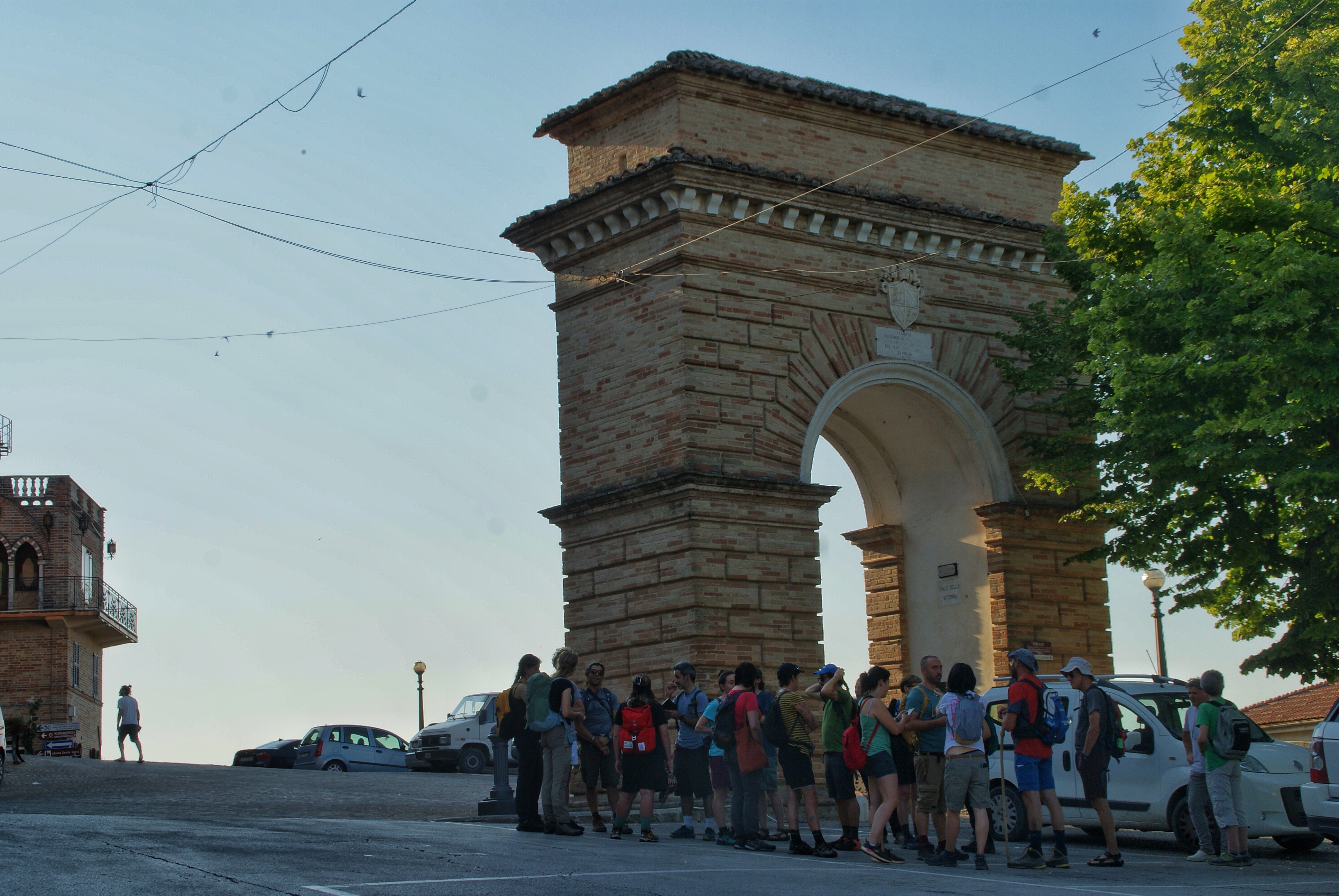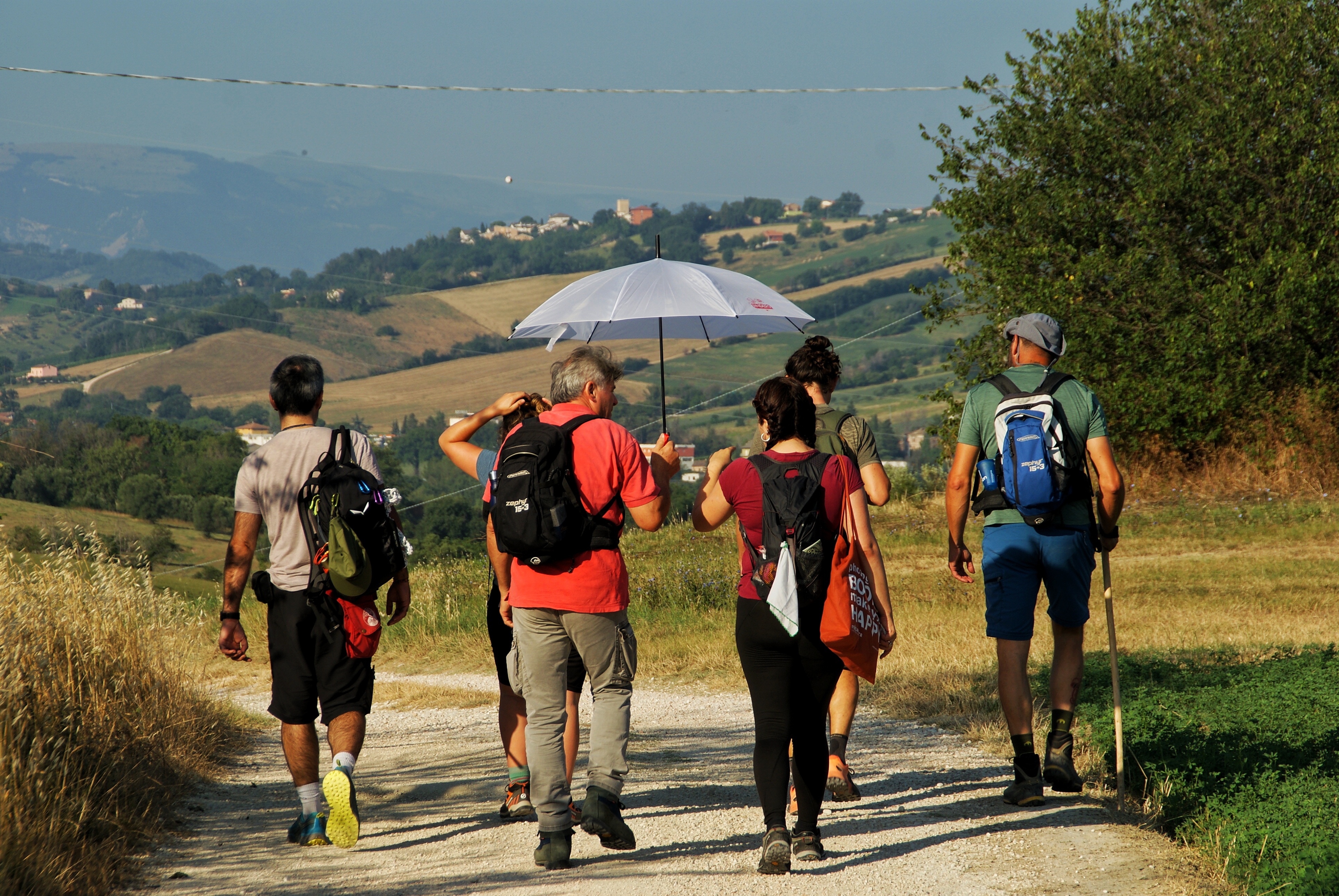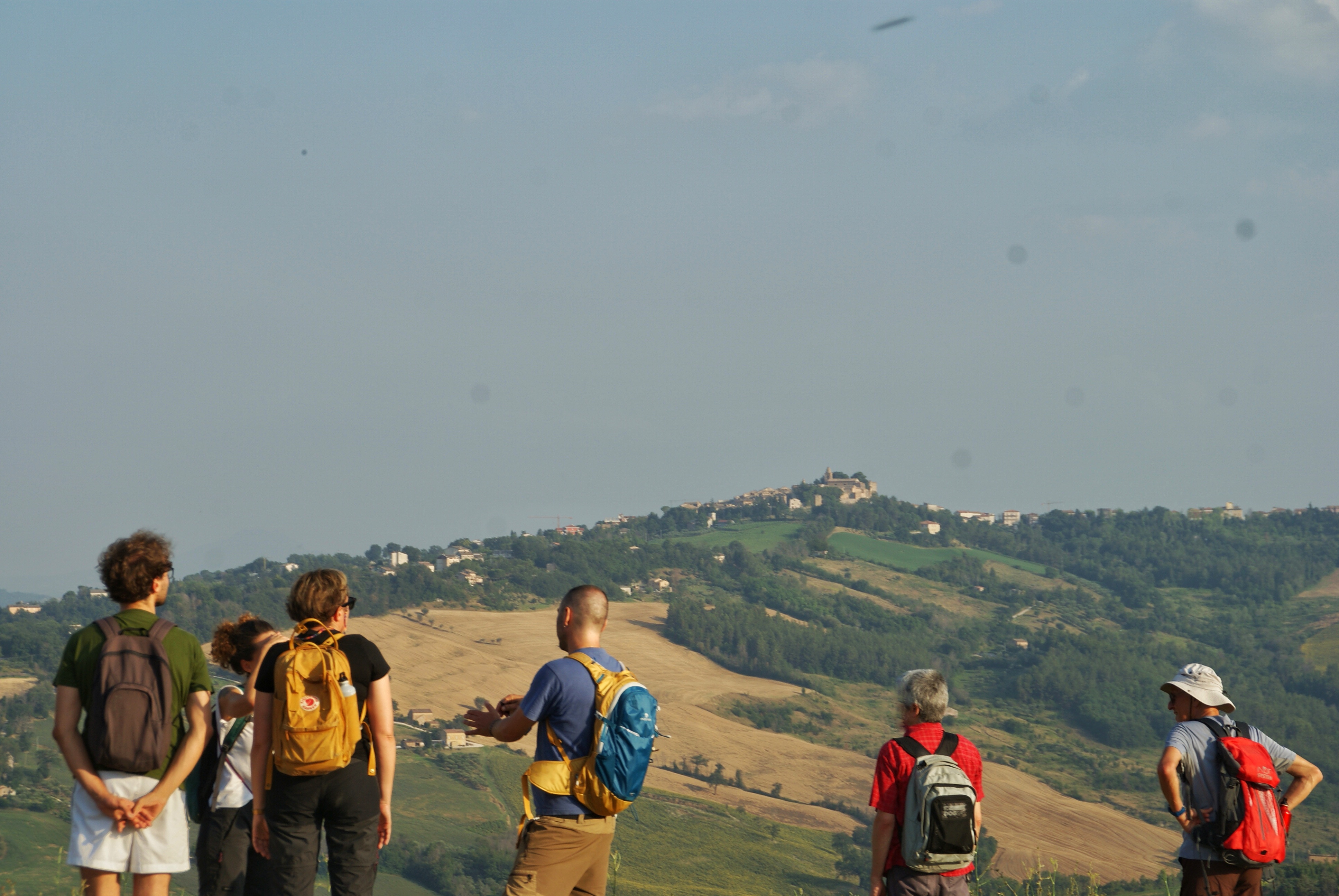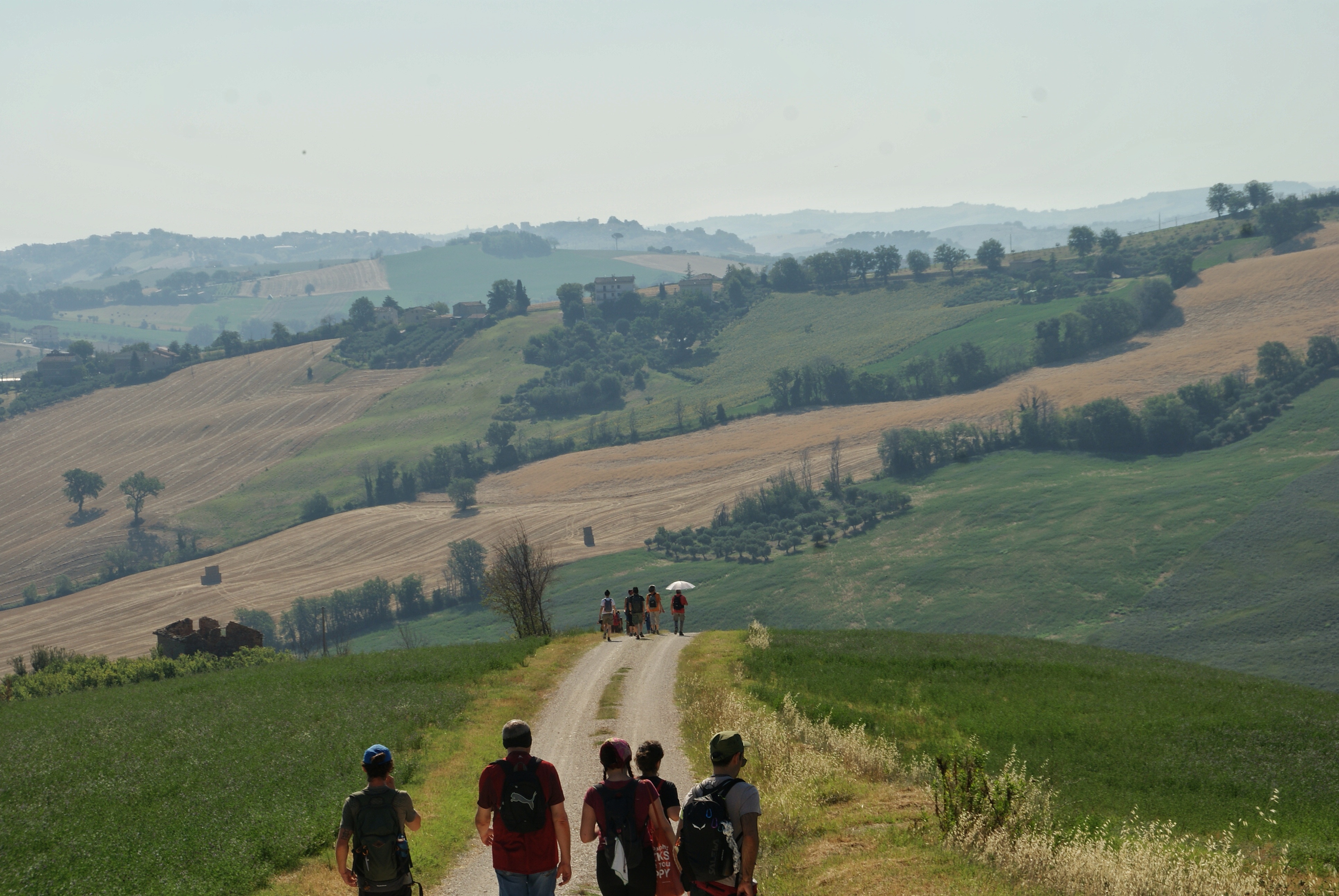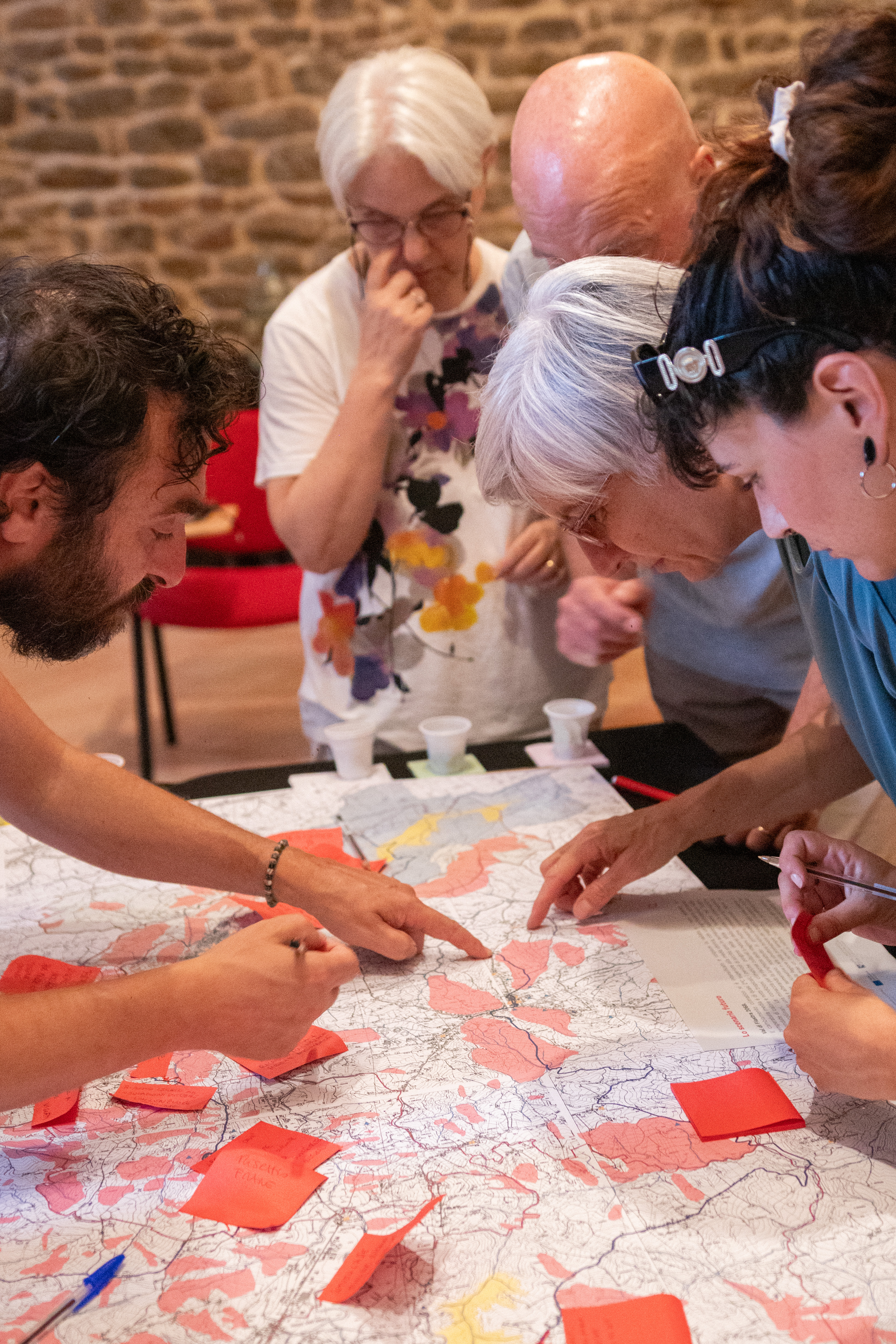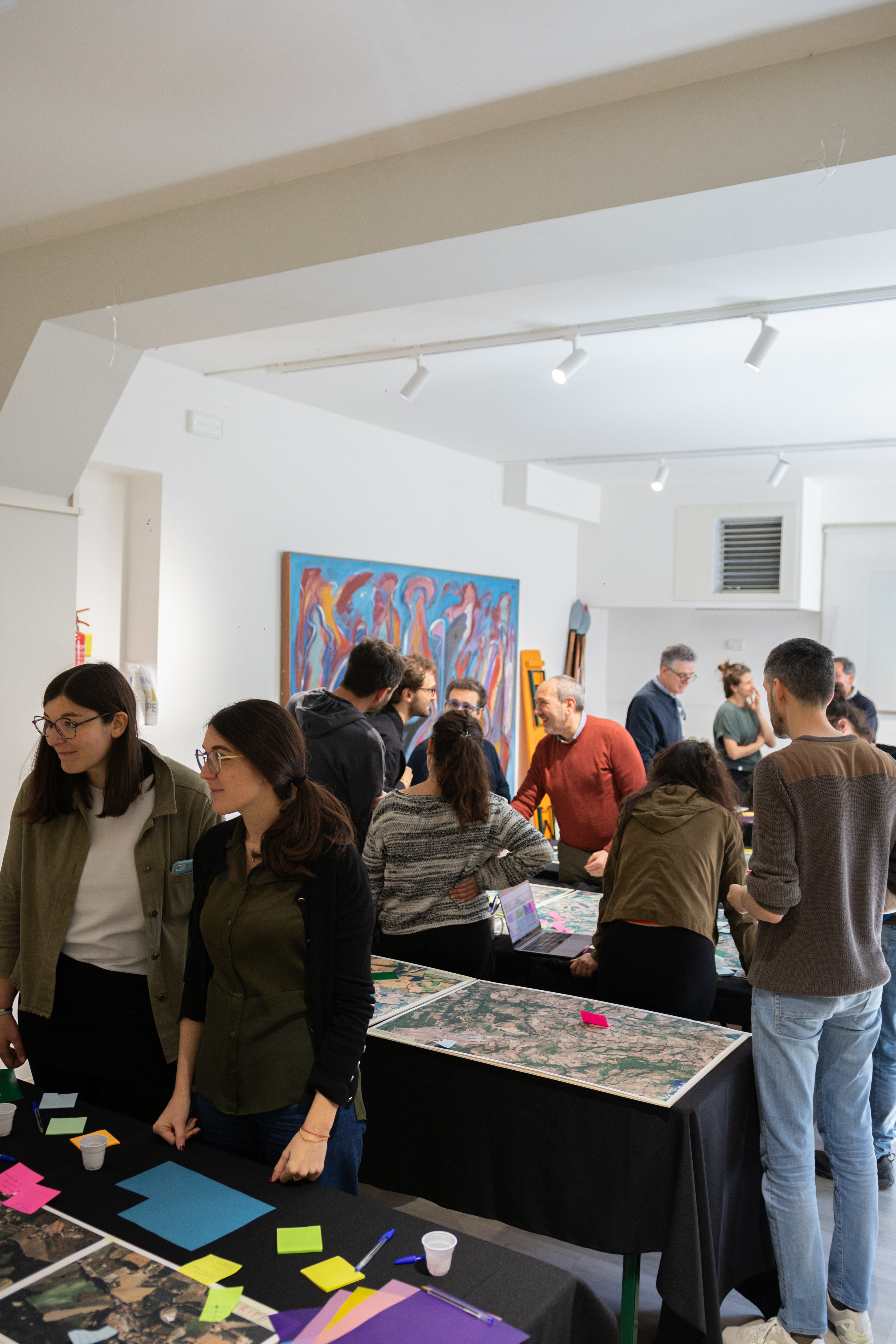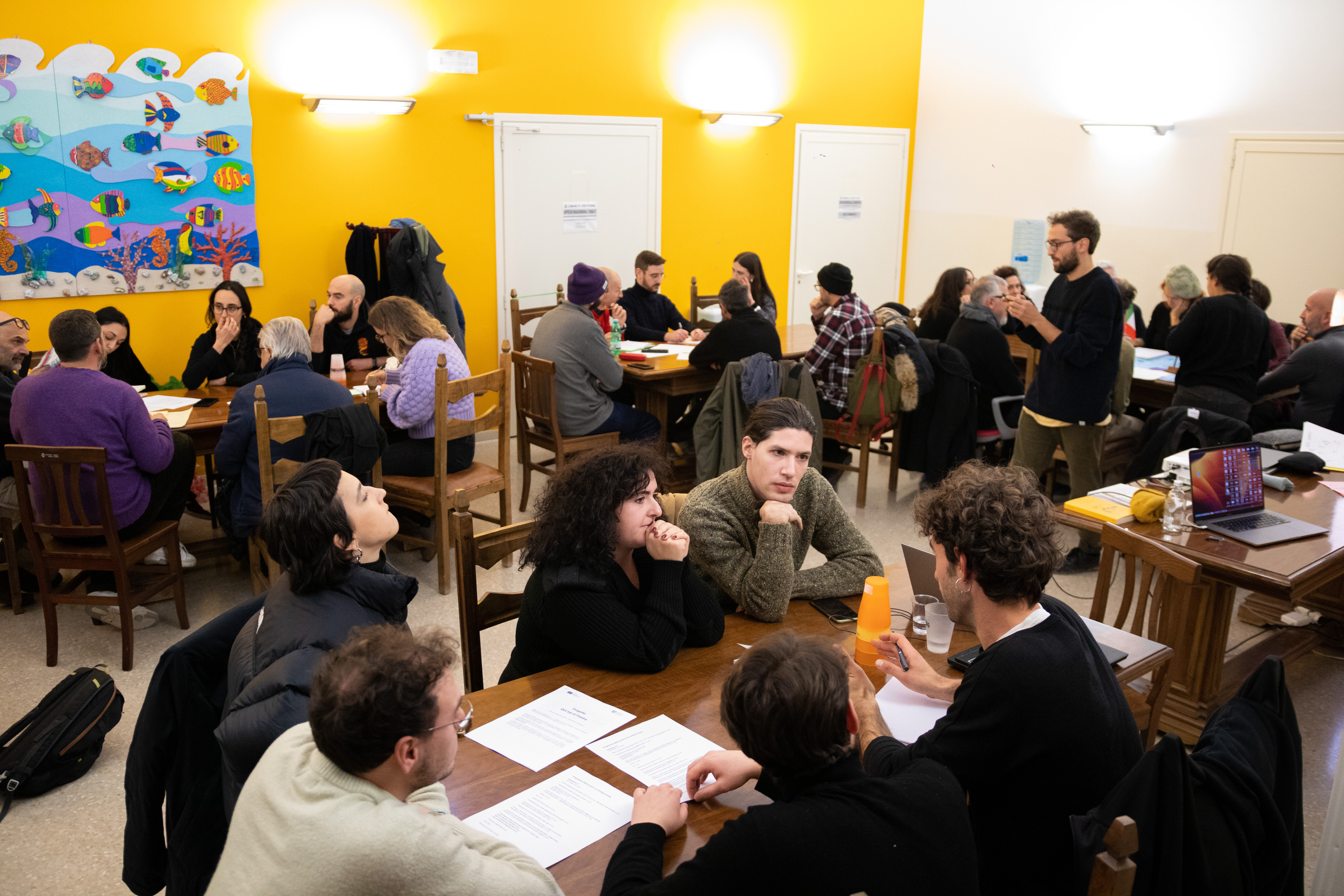The Val di Fiastra Local Project
Co-designing a sustainable and inclusive Local Project for inter-municipal rural regeneration
Building on the “Borgofuturo+” process (2020–2022) and the “Qui Val di Fiastra” project (2022–ongoing), our consortium will finalize the transformation of Palazzo Mastrocola, a landmark in Loro Piceno abandoned after the 2016 earthquake, into the hub of a network of 6 Fiastra Valley municipalities. Rooted in circular economy principles, local craftsmanship, and community-led decision-making, this will deliver a Model with replicable solutions for NEB-oriented rural regeneration.
Italy
Via Regina Margherita n. 25-27-29-31, Loro Piceno (MC)
Prototype level
Yes
Yes
Yes
No
No
043022: Loro Piceno (IT)
Our consortium will advance the valley-wide regeneration process initiated in 2020, transforming Palazzo Mastrocola—left unusable by the 2016 seismic events—into a hub for 6 Fiastra Valley municipalities. The restoration of its 19th-century ground floor follows circular economy principles to create affordable tourist accommodations that reduce environmental impact, preserve cultural heritage, and foster community-led craftsmanship. Demonstrating how adaptive reuse drives economic revitalization, social cohesion, and slow tourism, we’ll deliver a replicable Model for small and rural EU municipalities.
Target
Residents face economic stagnation, job scarcity, and outmigration and seek initiatives that boost the economy and social interaction.
Businesses&artisans struggle with declining demand due to depopulation and seasonal activity.
Tourists seek authentic experiences, cultural immersion, and sustainable accommodations.
Municipal authorities&stakeholders aim to prevent depopulation, preserve cultural heritage, drive sustainable growth, balance development with environmental and social responsibility, and attract investment.
Objectives
SO1. Strengthen local economy
SO2. Promote social inclusion within the community
SO3. Enhance Loro Piceno’s cultural and architectural heritage
SO4. Develop participatory governance for citizens, stakeholders, and experts
Expected outcomes
ER1 +40% jobs and business opportunities in craftsmanship, hospitality, and culture
ER2 +70% participatory initiatives for community cohesion
ER3 Full restoration of Palazzo Mastrocola
ER4 A scalable governance model for EU municipalities
This initiative complements the "Qui Val di Fiastra" project (NextGeneration EU - https://www.quivaldifiastra.com/index.php), developed by our Municipality in partnership with Ripe San Ginesio and Colmurano. Through 15 interventions, we aim to combat depopulation in the Valley, increase cultural participation, and strengthen the local economy.
Target
Residents face economic stagnation, job scarcity, and outmigration and seek initiatives that boost the economy and social interaction.
Businesses&artisans struggle with declining demand due to depopulation and seasonal activity.
Tourists seek authentic experiences, cultural immersion, and sustainable accommodations.
Municipal authorities&stakeholders aim to prevent depopulation, preserve cultural heritage, drive sustainable growth, balance development with environmental and social responsibility, and attract investment.
Objectives
SO1. Strengthen local economy
SO2. Promote social inclusion within the community
SO3. Enhance Loro Piceno’s cultural and architectural heritage
SO4. Develop participatory governance for citizens, stakeholders, and experts
Expected outcomes
ER1 +40% jobs and business opportunities in craftsmanship, hospitality, and culture
ER2 +70% participatory initiatives for community cohesion
ER3 Full restoration of Palazzo Mastrocola
ER4 A scalable governance model for EU municipalities
This initiative complements the "Qui Val di Fiastra" project (NextGeneration EU - https://www.quivaldifiastra.com/index.php), developed by our Municipality in partnership with Ripe San Ginesio and Colmurano. Through 15 interventions, we aim to combat depopulation in the Valley, increase cultural participation, and strengthen the local economy.
Community participation
Sustainability
Cultural heritage preservation
Rural regeneration
Slow tourism
Our initiative embodies the NEB core value of sustainability through the adaptive reuse of Palazzo Mastrocola, reducing environmental impact while preserving cultural heritage. Instead of new construction, we restore existing infrastructure, minimizing waste and resource-intensive processes. This builds on the “Qui Val di Fiastra” project, which fosters sustainable practices through landscape enhancement—understood as the dynamic relationship between human communities and ecosystems. Specifically, we:
- promote environmental education with local schools to strengthen ecological awareness;
- facilitate access to the territory via the Anello della Val di Fiastra (https://www.anellovaldifiastra.it/), a cultural trekking route designed to reconnect residents and visitors with the valley’s natural and historical heritage;
- support cultural activation in remote locations through a mobile unit for live performances.
In the specific context of Palazzo Mastrocola, we:
- maximize material efficiency, reusing structural elements and sourcing at least 40% of materials sustainably;
- prioritize local resources, cutting transportation-related emissions by 70%.
- integrate eco-conscious design, energy-efficient systems, and durable materials, adhering to EU green building standards.
The restoration process also relies on traditional craftsmanship and local building techniques, ensuring sustainability and the preservation of Loro Piceno’s architectural identity: engaging local artisans and businesses, we protect historic construction methods and generate economic opportunities, linking environmental sustainability with long-term economic resilience through sustainable tourism. Additionally, a low-carbon approach has been implemented in the construction and operational phases of the tourist accommodations, with enhanced insulation, natural ventilation, and solar shading to reduce heating and cooling needs, reduce energy consumption, and minimize waste.
- promote environmental education with local schools to strengthen ecological awareness;
- facilitate access to the territory via the Anello della Val di Fiastra (https://www.anellovaldifiastra.it/), a cultural trekking route designed to reconnect residents and visitors with the valley’s natural and historical heritage;
- support cultural activation in remote locations through a mobile unit for live performances.
In the specific context of Palazzo Mastrocola, we:
- maximize material efficiency, reusing structural elements and sourcing at least 40% of materials sustainably;
- prioritize local resources, cutting transportation-related emissions by 70%.
- integrate eco-conscious design, energy-efficient systems, and durable materials, adhering to EU green building standards.
The restoration process also relies on traditional craftsmanship and local building techniques, ensuring sustainability and the preservation of Loro Piceno’s architectural identity: engaging local artisans and businesses, we protect historic construction methods and generate economic opportunities, linking environmental sustainability with long-term economic resilience through sustainable tourism. Additionally, a low-carbon approach has been implemented in the construction and operational phases of the tourist accommodations, with enhanced insulation, natural ventilation, and solar shading to reduce heating and cooling needs, reduce energy consumption, and minimize waste.
Our initiative showcases how high-quality design and heritage preservation drive rural regeneration, fully embodying the NEB value of aesthetics. We are transforming the ground-floor of Palazzo Mastrocola—a 19th-century residence formed by merging four adjacent houses, spanning 1000 sqm over four levels, with a panoramic terrace and an 800 sqm garden—into a beautifully designed tourist residence where architecture, interior design, and cultural heritage merge.
Beyond visual beauty, it enhances comfort, well-being, and emotional connection to space: carefully selected materials, colors, and lighting will create a warm, welcoming atmosphere, improving physical and mental well-being; designer furnishings will complement the historic character while ensuring modern functionality and comfort.
The initiative strengthens ties between Palazzo Mastrocola and Qui Val di Fiastra's Digital Ecosystem (https://www.quivaldifiastra.com/index.php), embedding local craftsmanship and cultural traditions into the design and hosted activities. A key space, the Craft HUB 2.0 (https://www.quivaldifiastra.com/index.php), will offer guests hands-on workshops with artisans, immersing them in local creative practices.
The interior design reflects Loro Piceno’s cultural identity, blending historical preservation with contemporary aesthetics: original architectural details will be maintained while integrating modern comforts, and the former commercial spaces on the ground floor will now house:
- a Tourist Information Office;
- a high-quality tourist residence with an open-plan living room and kitchen, a single and a master bedroom, and an accessible bathroom.
The initiative enriches the region’s aesthetic and cultural experience while fostering sustainable local tourism: high-quality furnishings will restore these historic spaces for the community, strengthening local tourism— a key economic driver for Loro Piceno and nearby municipalities—and helping mitigate employment challenges.
Beyond visual beauty, it enhances comfort, well-being, and emotional connection to space: carefully selected materials, colors, and lighting will create a warm, welcoming atmosphere, improving physical and mental well-being; designer furnishings will complement the historic character while ensuring modern functionality and comfort.
The initiative strengthens ties between Palazzo Mastrocola and Qui Val di Fiastra's Digital Ecosystem (https://www.quivaldifiastra.com/index.php), embedding local craftsmanship and cultural traditions into the design and hosted activities. A key space, the Craft HUB 2.0 (https://www.quivaldifiastra.com/index.php), will offer guests hands-on workshops with artisans, immersing them in local creative practices.
The interior design reflects Loro Piceno’s cultural identity, blending historical preservation with contemporary aesthetics: original architectural details will be maintained while integrating modern comforts, and the former commercial spaces on the ground floor will now house:
- a Tourist Information Office;
- a high-quality tourist residence with an open-plan living room and kitchen, a single and a master bedroom, and an accessible bathroom.
The initiative enriches the region’s aesthetic and cultural experience while fostering sustainable local tourism: high-quality furnishings will restore these historic spaces for the community, strengthening local tourism— a key economic driver for Loro Piceno and nearby municipalities—and helping mitigate employment challenges.
Our initiative embraces the NEB value of inclusion by ensuring that the entire community of the Fiastra Valley, together with tourists and service providers, benefits from the revitalization of Palazzo Mastrocola.
In every step, we prioritize universal accessibility, ensuring that visitors, including those with reduced mobility, can fully experience the space: thoughtful barrier-free pathways, adaptable room layouts, and user-friendly facilities will make the residence welcoming to diverse guests, promoting inclusive tourism in a rural setting.
Affordability is another key factor, as we seek to make local cultural tourism accessible to a wider audience without compromising the quality of the experience: engaging with local businesses, artisans, and service providers serves the purpose of fostering economic inclusion and ensuring that benefits stay within the community; our attention for locally crafted furnishings, regionally sourced materials, and community-driven hospitality services is aimed at strengthening the local economy, creating opportunities for artisans and entrepreneurs.
Beyond physical accessibility and economic affordability, inclusion is fully embedded in our governance Model: since 2022, with the “Qui Val di Fiastra” Italian NRF, local stakeholders have been fully engaged in the decision-making process, ensuring the project reflects their needs and aspirations, while the community has been involved in the “RURACTIVE” Horizon Europe project (https://www.ruractive.eu), strengthening community ownership, responsibility, and pride in Loro Piceno’s heritage.
The result will be fully restored historically significant but underutilized infrastructure into a community-integrated and networking hub– a Model for inclusive rural regeneration demonstrating how the adaptive reuse of cultural heritage can strengthen social cohesion, support economic growth, and ensure that small municipalities remain attractive and livable for future generations.
In every step, we prioritize universal accessibility, ensuring that visitors, including those with reduced mobility, can fully experience the space: thoughtful barrier-free pathways, adaptable room layouts, and user-friendly facilities will make the residence welcoming to diverse guests, promoting inclusive tourism in a rural setting.
Affordability is another key factor, as we seek to make local cultural tourism accessible to a wider audience without compromising the quality of the experience: engaging with local businesses, artisans, and service providers serves the purpose of fostering economic inclusion and ensuring that benefits stay within the community; our attention for locally crafted furnishings, regionally sourced materials, and community-driven hospitality services is aimed at strengthening the local economy, creating opportunities for artisans and entrepreneurs.
Beyond physical accessibility and economic affordability, inclusion is fully embedded in our governance Model: since 2022, with the “Qui Val di Fiastra” Italian NRF, local stakeholders have been fully engaged in the decision-making process, ensuring the project reflects their needs and aspirations, while the community has been involved in the “RURACTIVE” Horizon Europe project (https://www.ruractive.eu), strengthening community ownership, responsibility, and pride in Loro Piceno’s heritage.
The result will be fully restored historically significant but underutilized infrastructure into a community-integrated and networking hub– a Model for inclusive rural regeneration demonstrating how the adaptive reuse of cultural heritage can strengthen social cohesion, support economic growth, and ensure that small municipalities remain attractive and livable for future generations.
The Val di Fiastra community and stakeholders have played a central role in shaping our initiative, integrating local voices in decision-making and long-term development.
A key aspect is the "Qui Val di Fiastra" project, where our Municipality collaborates with Ripe San Ginesio and Colmurano to boost cultural participation and economic growth: residents, businesses, and cultural organizations contribute to innovative tourism and rural regeneration strategies, reinforcing the value of community-driven development.
At the heart of this participatory process is the Osservatorio del Paesaggio (https://www.quivaldifiastra.com/index.php), a research center dedicated to studying and preserving local landscapes: more than a research hub, it is a civic space for participatory dialogue, engaging citizens in shaping the Valley’s future–conceived during the Borgofuturo+ festival (2020), it fosters citizen involvement through workshops, consultations, and open forums. The Osservatorio also connects Palazzo Mastrocola’s activities with broader territorial strategies, encouraging discussions on landscape valorization, sustainable tourism, and future development.
Additionally, we are part of "RURACTIVE," a Horizon Europe project promoting community-led, place-based solutions for rural sustainability. Addressing key areas like mobility, energy transition, agroecology, cultural innovation, and nature-based tourism, it aligns with Palazzo Mastrocola’s transformation.
The restoration and furnishing of the residence with locally crafted elements will further stimulate economic activity and reinforce community participation; creating a welcoming, high-quality environment will attract longer-staying visitors, increasing local spending and benefiting businesses and service providers; a well-curated tourist experience will strengthen connections between visitors and the local community, fostering a deeper appreciation for the Fiastra Valley’s heritage, traditions, and hospitality.
A key aspect is the "Qui Val di Fiastra" project, where our Municipality collaborates with Ripe San Ginesio and Colmurano to boost cultural participation and economic growth: residents, businesses, and cultural organizations contribute to innovative tourism and rural regeneration strategies, reinforcing the value of community-driven development.
At the heart of this participatory process is the Osservatorio del Paesaggio (https://www.quivaldifiastra.com/index.php), a research center dedicated to studying and preserving local landscapes: more than a research hub, it is a civic space for participatory dialogue, engaging citizens in shaping the Valley’s future–conceived during the Borgofuturo+ festival (2020), it fosters citizen involvement through workshops, consultations, and open forums. The Osservatorio also connects Palazzo Mastrocola’s activities with broader territorial strategies, encouraging discussions on landscape valorization, sustainable tourism, and future development.
Additionally, we are part of "RURACTIVE," a Horizon Europe project promoting community-led, place-based solutions for rural sustainability. Addressing key areas like mobility, energy transition, agroecology, cultural innovation, and nature-based tourism, it aligns with Palazzo Mastrocola’s transformation.
The restoration and furnishing of the residence with locally crafted elements will further stimulate economic activity and reinforce community participation; creating a welcoming, high-quality environment will attract longer-staying visitors, increasing local spending and benefiting businesses and service providers; a well-curated tourist experience will strengthen connections between visitors and the local community, fostering a deeper appreciation for the Fiastra Valley’s heritage, traditions, and hospitality.
The small&rural municipalities of the Fiastra Valley have engaged stakeholders at multiple levels through a coordinated, participatory approach to project design and implementation.
LOCAL LEVEL
The "Qui Val di Fiastra" project has been instrumental in shaping our initiative: since 2022, we have worked to increase cultural participation, activate local economies, and combat depopulation through sustainable rural development, environmental protection, and inclusive participation. This foundation was laid during the territorial roundtables of 2020 and 2021, involving 100+ local participants across 4 development areas:
Regeneration infrastructure (historic centers, soft mobility, and museum networks)
Environmental and territorial education
Valley-wide cultural identity and imagination
Gastronomy and local production
Initially structured as brainstorming sessions, the roundtables evolved into co-design workshops, culminating in the publication of “Borgofuturo+: Un progetto locale per le aree interne” (Quodlibet Editore, https://www.quodlibet.it/libro/9788822907165), documenting methodologies and outcomes.
REGIONAL&NATIONAL LEVEL
Our initiative benefits from partnerships with universities, research centers, and cultural organizations, including the University of Bologna and University of Camerino – School of Architecture and Design, contributing expertise in landscape research, digital ecosystems, and evidence-based regeneration models.
EU LEVEL
Our work is linked to Horizon Europe’s "RURACTIVE" project, where Loro Piceno and the Fiastra Valley played a key role in defining local challenges and identifying solutions for climate-resilient cultural events, sustainable agriculture, and direct sales of local products.
To ensure that interventions are directly aligned with local priorities, we recently launched an international call for innovative projects focused on rural sustainability and resilience, driving tailored, impactful solutions for the region.
LOCAL LEVEL
The "Qui Val di Fiastra" project has been instrumental in shaping our initiative: since 2022, we have worked to increase cultural participation, activate local economies, and combat depopulation through sustainable rural development, environmental protection, and inclusive participation. This foundation was laid during the territorial roundtables of 2020 and 2021, involving 100+ local participants across 4 development areas:
Regeneration infrastructure (historic centers, soft mobility, and museum networks)
Environmental and territorial education
Valley-wide cultural identity and imagination
Gastronomy and local production
Initially structured as brainstorming sessions, the roundtables evolved into co-design workshops, culminating in the publication of “Borgofuturo+: Un progetto locale per le aree interne” (Quodlibet Editore, https://www.quodlibet.it/libro/9788822907165), documenting methodologies and outcomes.
REGIONAL&NATIONAL LEVEL
Our initiative benefits from partnerships with universities, research centers, and cultural organizations, including the University of Bologna and University of Camerino – School of Architecture and Design, contributing expertise in landscape research, digital ecosystems, and evidence-based regeneration models.
EU LEVEL
Our work is linked to Horizon Europe’s "RURACTIVE" project, where Loro Piceno and the Fiastra Valley played a key role in defining local challenges and identifying solutions for climate-resilient cultural events, sustainable agriculture, and direct sales of local products.
To ensure that interventions are directly aligned with local priorities, we recently launched an international call for innovative projects focused on rural sustainability and resilience, driving tailored, impactful solutions for the region.
The implementation of our initiative is rooted in an interdisciplinary approach, also thanks to the collaboration of Inabita Società Cooperativa (https://www.inabitalab.com/), a network of environmental researchers, architects, and planners specializing in territorial regeneration through participatory methods. Inabita tackles the environmental, social, and cultural challenges of inner areas, fostering transformation through collective action research. This framework integrates diverse expertise, enabling cross-sector collaboration in 4 key areas:
1. Landscape Research – Within the "Osservatorio del Paesaggio" (Qui Val di Fiastra, https://www.quivaldifiastra.com/index.php), researchers from University of Bologna and University of Camerino mapped and documented cultural landscapes, guiding design choices that respect Palazzo Mastrocola’s historic and environmental context.
2. Participatory Design – Over 2 years, local stakeholders, residents, businesses, and municipal authorities co-designed solutions through workshops and consultations under "Qui Val di Fiastra", shaping tourism, cultural programming, and economic opportunities. RURACTIVE’s model further connected researchers, policymakers, and citizens for community-led rural sustainability.
3. Ecology & Sustainability – Focused on adaptive reuse and minimal environmental impact, the initiative follows circular economy principles, prioritizing local materials, traditional building techniques, and energy efficiency. Environmental experts and artisans have ensured low-impact construction while preserving the building’s historic integrity.
4. Local Community Empowerment – Our consortium drives business, tourism, and cultural sector engagement in shaping the revitalization’s economic model. "Qui Val di Fiastra" fosters cultural participation and entrepreneurship, while RURACTIVE connects Loro Piceno with European rural communities working on smart, inclusive, and sustainable solutions.
1. Landscape Research – Within the "Osservatorio del Paesaggio" (Qui Val di Fiastra, https://www.quivaldifiastra.com/index.php), researchers from University of Bologna and University of Camerino mapped and documented cultural landscapes, guiding design choices that respect Palazzo Mastrocola’s historic and environmental context.
2. Participatory Design – Over 2 years, local stakeholders, residents, businesses, and municipal authorities co-designed solutions through workshops and consultations under "Qui Val di Fiastra", shaping tourism, cultural programming, and economic opportunities. RURACTIVE’s model further connected researchers, policymakers, and citizens for community-led rural sustainability.
3. Ecology & Sustainability – Focused on adaptive reuse and minimal environmental impact, the initiative follows circular economy principles, prioritizing local materials, traditional building techniques, and energy efficiency. Environmental experts and artisans have ensured low-impact construction while preserving the building’s historic integrity.
4. Local Community Empowerment – Our consortium drives business, tourism, and cultural sector engagement in shaping the revitalization’s economic model. "Qui Val di Fiastra" fosters cultural participation and entrepreneurship, while RURACTIVE connects Loro Piceno with European rural communities working on smart, inclusive, and sustainable solutions.
Unlike conventional tourism-focused regeneration processes, our initiative will deliver an innovative Model for rural and small EU municipalities, integrating sustainability, community engagement, and knowledge-based economic resilience. Currently, rural towns face either neglect or top-down, high-investment interventions that fail to integrate local knowledge, circular economy principles, or climate-adaptive strategies. We fill this gap by creating a scalable framework for rural revitalization that is cost-effective, locally driven, and environmentally responsible.
The innovative Model (D3.1), easily replicable by small municipalities across the EU, includes:
- Community-led transformation: we engage residents, businesses, and cultural organizations through co-design workshops and public consultations to facilitate social cohesion, foster economic opportunities that remain within the territory, and ensure long-term sustainability.
- Leveraging research for sustainable rural development: through partnerships with the University of Bologna and Camerino within the “Qui Val di Fiastra” and “RURACTIVE” projects, we integrate landscape preservation strategies and datadriven sustainability tools into our initiative, ensuring scientific knowledge informs tourism development and providing a replicable framework for research-driven rural transformation.
- Accessing EU networks for innovation: participation in EU-funded projects like “RURACTIVE” empowered our consortium with access to cutting-edge solutions for sustainable rural economies and climate-adaptive strategies, and positioned us within a European innovation network.
- Circular economy in rural regeneration: we repurpose Palazzo Mastrocola instead of opting for costly demolitions or new construction, using local materials, traditional techniques, and energy-efficient solutions to reduce environmental impact while ensuring lowcost, high-impact restoration that preserves cultural authenticity and meets modern need
The innovative Model (D3.1), easily replicable by small municipalities across the EU, includes:
- Community-led transformation: we engage residents, businesses, and cultural organizations through co-design workshops and public consultations to facilitate social cohesion, foster economic opportunities that remain within the territory, and ensure long-term sustainability.
- Leveraging research for sustainable rural development: through partnerships with the University of Bologna and Camerino within the “Qui Val di Fiastra” and “RURACTIVE” projects, we integrate landscape preservation strategies and datadriven sustainability tools into our initiative, ensuring scientific knowledge informs tourism development and providing a replicable framework for research-driven rural transformation.
- Accessing EU networks for innovation: participation in EU-funded projects like “RURACTIVE” empowered our consortium with access to cutting-edge solutions for sustainable rural economies and climate-adaptive strategies, and positioned us within a European innovation network.
- Circular economy in rural regeneration: we repurpose Palazzo Mastrocola instead of opting for costly demolitions or new construction, using local materials, traditional techniques, and energy-efficient solutions to reduce environmental impact while ensuring lowcost, high-impact restoration that preserves cultural authenticity and meets modern need
Our initiative follows a participatory design methodology built on real community needs and the existing social, cultural, and economic fabric of the Fiastra Valley.
It is rooted in over a decade of community engagement, originating from the support given by all 6 Municipalities to the Borgofuturo (https://borgofuturo.net/) festival, launched in 2010, which evolved into a broader territorial regeneration strategy in 2020, expanding across the entire Fiastra Valley.
In the summer of 2020, Borgofuturo initiated a participatory process to co-design a shared, sustainable, and innovative vision for the Valley, addressing sustainability and quality of life through community-led discussions: the first step was a territorial listening phase, with discussions held during the BF+ festival, where communities identified key regeneration themes; this led to the definition of strategic project lines, culminating in a co-design phase where local stakeholders worked on specific implementation strategies. The process included our Municipality plus those of Ripe San Ginesio, Colmurano, Urbisaglia, Sant’Angelo in Pontano, and San Ginesio, demonstrating a shared commitment to rural development.
Rather than just inviting stakeholders to provide feedback, this methodology actively engages them based on their societal roles, ensuring meaningful contributions that enhance long-term sustainability: teachers contribute to environmental education, small-scale producers participate in sustainable construction, and local artisans help select and apply traditional materials and techniques. Such a bottom-up approach, valuing local knowledge and expertise, made our stakeholders key actors in the transformation process.
With our initiative, we’ll work to develop an innovative Model for rural and small EU municipalities (D3.1), integrating this approach through structured workshops, consultations, and pilot actions hosted in the Fiastra Valley, reinforcing multi-stakeholder cooperation.
It is rooted in over a decade of community engagement, originating from the support given by all 6 Municipalities to the Borgofuturo (https://borgofuturo.net/) festival, launched in 2010, which evolved into a broader territorial regeneration strategy in 2020, expanding across the entire Fiastra Valley.
In the summer of 2020, Borgofuturo initiated a participatory process to co-design a shared, sustainable, and innovative vision for the Valley, addressing sustainability and quality of life through community-led discussions: the first step was a territorial listening phase, with discussions held during the BF+ festival, where communities identified key regeneration themes; this led to the definition of strategic project lines, culminating in a co-design phase where local stakeholders worked on specific implementation strategies. The process included our Municipality plus those of Ripe San Ginesio, Colmurano, Urbisaglia, Sant’Angelo in Pontano, and San Ginesio, demonstrating a shared commitment to rural development.
Rather than just inviting stakeholders to provide feedback, this methodology actively engages them based on their societal roles, ensuring meaningful contributions that enhance long-term sustainability: teachers contribute to environmental education, small-scale producers participate in sustainable construction, and local artisans help select and apply traditional materials and techniques. Such a bottom-up approach, valuing local knowledge and expertise, made our stakeholders key actors in the transformation process.
With our initiative, we’ll work to develop an innovative Model for rural and small EU municipalities (D3.1), integrating this approach through structured workshops, consultations, and pilot actions hosted in the Fiastra Valley, reinforcing multi-stakeholder cooperation.
Our initiative will deliver a scalable and adaptable Model (D3.1) for rural revitalization in small EU municipalities, transferable to regions, heritage sites, and communities facing similar socio-economic and environmental challenges.
REPLICABLE ELEMENTS
1. Participatory governance Model – it engages stakeholders based on expertise: educators support environmental education, artisans guide sustainable material selection, and producers inform economic strategies. Municipalities can replicate this model by setting up local working groups, stakeholder roundtables, and co-design workshops, ensuring community-driven cultural projects, tourism, and public space management.
2. Adaptive reuse of historic buildings – a step-by-step approach to repurposing abandoned structures into economically viable spaces. Municipalities can first secure structural stability, and then introduce new functions like community spaces, tourism infrastructure, or business hubs, ensuring a sustainable transformation of heritage sites.
3. Sustainable tourism Model – it prioritizes slow, experience-based tourism over mass tourism, built around the Anello della Val di Fiastra cultural trekking route. This model integrates businesses, artisans, and cultural operators into the visitor experience, fostering economic benefits while preserving authenticity. By embedding visitor accommodations within a restored landmark and establishing a Tourist Information Office, municipalities can stimulate local economies while preserving heritage.
4. Circular economy framework – it supports rural areas in repurposing underutilized spaces with local materials, traditional techniques, and energy-efficient solutions, promoting craftsmanship and sustainability. This adaptable approach helps municipalities connect cultural heritage, environmental goals, and economic resilience, offering innovative pathways for revitalization across Europe.
REPLICABLE ELEMENTS
1. Participatory governance Model – it engages stakeholders based on expertise: educators support environmental education, artisans guide sustainable material selection, and producers inform economic strategies. Municipalities can replicate this model by setting up local working groups, stakeholder roundtables, and co-design workshops, ensuring community-driven cultural projects, tourism, and public space management.
2. Adaptive reuse of historic buildings – a step-by-step approach to repurposing abandoned structures into economically viable spaces. Municipalities can first secure structural stability, and then introduce new functions like community spaces, tourism infrastructure, or business hubs, ensuring a sustainable transformation of heritage sites.
3. Sustainable tourism Model – it prioritizes slow, experience-based tourism over mass tourism, built around the Anello della Val di Fiastra cultural trekking route. This model integrates businesses, artisans, and cultural operators into the visitor experience, fostering economic benefits while preserving authenticity. By embedding visitor accommodations within a restored landmark and establishing a Tourist Information Office, municipalities can stimulate local economies while preserving heritage.
4. Circular economy framework – it supports rural areas in repurposing underutilized spaces with local materials, traditional techniques, and energy-efficient solutions, promoting craftsmanship and sustainability. This adaptable approach helps municipalities connect cultural heritage, environmental goals, and economic resilience, offering innovative pathways for revitalization across Europe.
1. Rural depopulation
Limited jobs, essential services, and social isolation drive rural decline across Europe. Through “QUI VAL DI FIASTRA” and “RURACTIVE”, we implement community-led strategies fostering economic, cultural, and social revitalization. Supported by the NEB Prize and the support in communication and dissemination, our initiative will:
- generate new opportunities in hospitality, crafts, food production, and cultural services, making Loro Piceno more attractive to residents and workers;
- amplify the project’s visibility at the EU level, fostering knowledge exchange and encouraging the replication of our Model in other rural communities.
2. Cultural heritage loss
Abandoned historic buildings erode local identity. Our sustainable conservation Model, building on Qui Val di Fiastra, preserves cultural heritage through adaptive reuse—seen in the restoration of historic villages and three HUBS. Palazzo Mastrocola’s transformation will create a functional yet authentic space, catalyzing sustainable rural development.
3. Economic inequality
Many rural development projects exclude small-scale producers, artisans, and businesses. We prioritize local stakeholders in decision-making, ensuring tourism-related income benefits the community. The Ecosistema Digitale (Qui Val di Fiastra) has already established an inclusive economic model, integrating locals into cultural and economic activities.
4. Climate change
Threatening built heritage and rural economies, climate change demands low-impact solutions. Rather than high-emission new construction, we adopt adaptive reuse, prioritizing energy efficiency, circular economy strategies, and sustainable materials to cut CO₂ emissions and minimize waste. Qui Val di Fiastra’s initiatives—environmental education in schools and the Anello della Val di Fiastra trekking route—promote low-impact exploration and reinforce the human-nature connection for sustainable ruraldevelopment
Limited jobs, essential services, and social isolation drive rural decline across Europe. Through “QUI VAL DI FIASTRA” and “RURACTIVE”, we implement community-led strategies fostering economic, cultural, and social revitalization. Supported by the NEB Prize and the support in communication and dissemination, our initiative will:
- generate new opportunities in hospitality, crafts, food production, and cultural services, making Loro Piceno more attractive to residents and workers;
- amplify the project’s visibility at the EU level, fostering knowledge exchange and encouraging the replication of our Model in other rural communities.
2. Cultural heritage loss
Abandoned historic buildings erode local identity. Our sustainable conservation Model, building on Qui Val di Fiastra, preserves cultural heritage through adaptive reuse—seen in the restoration of historic villages and three HUBS. Palazzo Mastrocola’s transformation will create a functional yet authentic space, catalyzing sustainable rural development.
3. Economic inequality
Many rural development projects exclude small-scale producers, artisans, and businesses. We prioritize local stakeholders in decision-making, ensuring tourism-related income benefits the community. The Ecosistema Digitale (Qui Val di Fiastra) has already established an inclusive economic model, integrating locals into cultural and economic activities.
4. Climate change
Threatening built heritage and rural economies, climate change demands low-impact solutions. Rather than high-emission new construction, we adopt adaptive reuse, prioritizing energy efficiency, circular economy strategies, and sustainable materials to cut CO₂ emissions and minimize waste. Qui Val di Fiastra’s initiatives—environmental education in schools and the Anello della Val di Fiastra trekking route—promote low-impact exploration and reinforce the human-nature connection for sustainable ruraldevelopment
Our initiative has been designed to reflect the NEB values and shape a Model for sustainable, inclusive, aesthetic rural regeneration.
Sustainability has been a core principle from the start: with a focus on repurposing an existing structure rather than building anew, our initiative relies on local materials, traditional craftsmanship, circular economy principles, and energy-efficient solutions to reduce environmental impact, informed by the nature-based solutions and climate-resilient strategies experienced with “Qui Val di Fiastra” and “RURACTIVE”.
Inclusion has been strongly embedded too: a participatory design process, with workshops and bottom-up consultations, has engaged residents, businesses, artisans, educators, and cultural organizations in shaping the project’s structure and decisions on tourism, cultural programming, and economic development.
Aesthetics and quality of experience guided us too, ensuring that Palazzo Mastrocola becomes a stimulating cultural space while preserving its architectural character, with functional and high-quality design choices to enhance both historical authenticity and visitor experience.
The next phase involves:
finalizing the structural adaptation of Palazzo Mastrocola in line with sustainable construction standards and eco-friendly design solutions;
fostering community-driven decisions through thematic workshops, where residents, local entrepreneurs, and cultural organizations will co-create governance, tourism management, and cultural programming strategies;
facilitate accessibility&affordability of the space, ensuring it is inclusive and welcoming, and foster a high-quality cultural experience for all community members and tourists.
Through “RURACTIVE” and “Qui Val di Fiastra”, we will finalize the implementation of smart rural development solutions, including digital tools for visitor engagement and climate-adaptive strategies to enhance the project's impact and make it a scalable Model for rural municipalities
Sustainability has been a core principle from the start: with a focus on repurposing an existing structure rather than building anew, our initiative relies on local materials, traditional craftsmanship, circular economy principles, and energy-efficient solutions to reduce environmental impact, informed by the nature-based solutions and climate-resilient strategies experienced with “Qui Val di Fiastra” and “RURACTIVE”.
Inclusion has been strongly embedded too: a participatory design process, with workshops and bottom-up consultations, has engaged residents, businesses, artisans, educators, and cultural organizations in shaping the project’s structure and decisions on tourism, cultural programming, and economic development.
Aesthetics and quality of experience guided us too, ensuring that Palazzo Mastrocola becomes a stimulating cultural space while preserving its architectural character, with functional and high-quality design choices to enhance both historical authenticity and visitor experience.
The next phase involves:
finalizing the structural adaptation of Palazzo Mastrocola in line with sustainable construction standards and eco-friendly design solutions;
fostering community-driven decisions through thematic workshops, where residents, local entrepreneurs, and cultural organizations will co-create governance, tourism management, and cultural programming strategies;
facilitate accessibility&affordability of the space, ensuring it is inclusive and welcoming, and foster a high-quality cultural experience for all community members and tourists.
Through “RURACTIVE” and “Qui Val di Fiastra”, we will finalize the implementation of smart rural development solutions, including digital tools for visitor engagement and climate-adaptive strategies to enhance the project's impact and make it a scalable Model for rural municipalities



